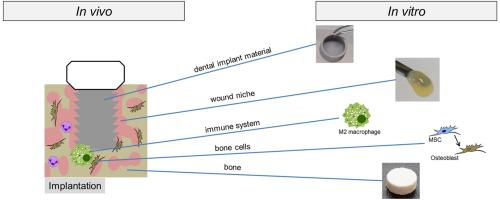Dental Materials ( IF 5 ) Pub Date : 2020-06-13 , DOI: 10.1016/j.dental.2020.04.020 Franziska Ehlicke 1 , Jonathan Berndt 2 , Nina Marichikj 1 , Doris Steinmüller-Nethl 3 , Heike Walles 4 , Ernst-Ulrich Berndt 2 , Jan Hansmann 4

|
Objectives
Before application in dental practice, novel dental materials are tested in vitro and in vivo to ensure safety and functionality. However, transferability between preclinical and clinical results is often limited. To increase the predictive power of preclinical testing, a biomimetic in vitro test system that mimics the wound niche after implantation was developed.
Methods
First, predetermined implant materials were treated with human blood plasma, M2 macrophages and bone marrow stromal stem cells. Thereby, the three-dimensional wound niche was simulated. Samples were cultured for 28 days, and subsequently analyzed for metabolic activity and biomineralization. Second test level involved a cell-infiltrated bone substitute material for an osseointegration assay to measure mechanical bonding between dental material and bone. Standard and novel dental materials validated the developed test approach.
Results
The developed test system for dental implant materials allowed quantification of biomineralization on implant surface and assessment of the functional stability of mineralized biomaterial-tissue interface. Human blood plasma, M2 macrophages and bone marrow stromal stem cells proved to be crucial components for predictive assessment of implant materials in vitro. Biocompatibility was demonstrated for all tested materials, whereas the degree of deposited mineralized extracellular matrix and mechanical stability differed between the tested materials. Highest amount of functional biomineralization was determined to be on carbon-coated implant surface.
Significance
As an ethical alternative to animal testing, the established in vitro dental test system provides an economic and mid-throughput evaluation of novel dental implant materials or modifications thereof, by applying two successive readout levels: biomineralization and osseointegration.
中文翻译:

仿生体外测试系统,用于评估牙科植入物材料。
目标
在应用于牙科实践之前,要对新型牙科材料进行体外和体内测试,以确保安全性和功能性。但是,临床前和临床结果之间的可转移性通常受到限制。为了提高临床前测试的预测能力,开发了一种仿生体外测试系统,该系统模拟了植入后的伤口位置。
方法
首先,用人血浆,M2巨噬细胞和骨髓基质干细胞处理预定的植入物材料。从而,模拟了三维伤口生态位。将样品培养28天,然后分析代谢活性和生物矿化。第二个测试级别涉及用于骨整合测定的细胞浸润的骨替代材料,以测量牙科材料与骨骼之间的机械结合。标准和新型牙科材料验证了开发的测试方法。
结果
针对牙科植入物材料开发的测试系统可以量化植入物表面的生物矿化作用,并评估矿化的生物材料-组织界面的功能稳定性。人体血浆,M2巨噬细胞和骨髓基质干细胞被证明是体外预测植入材料的关键组成部分。证明了所有测试材料的生物相容性,而矿化细胞外基质的沉积程度和机械稳定性在测试材料之间有所不同。确定最大量的功能生物矿化在碳涂层的植入物表面上。
意义
作为动物测试的替代选择,已建立的体外牙科测试系统通过应用两个连续的读数水平:生物矿化和骨整合,可以对新型牙科植入物材料或其改性进行经济且中等通量的评估。



























 京公网安备 11010802027423号
京公网安备 11010802027423号